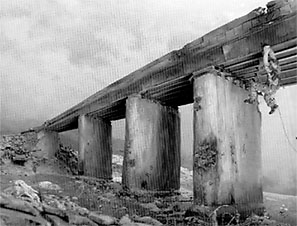I had never heard of John W. Ripley until this morning. Apparently, I’m not alone.
 “He’s the most revered war hero no one’s ever heard of,” Fred Schultz, senior editor of Naval History Magazine, told the New York Times in Mr. Ripley’s obituary today.
“He’s the most revered war hero no one’s ever heard of,” Fred Schultz, senior editor of Naval History Magazine, told the New York Times in Mr. Ripley’s obituary today.
It was Easter 1972 when 20,000 North Vietnamese troops and 200 tanks were heading for the South. Only a bridge separated the force from Ripley and 600 South Vietnamese soldiers. So Ripley blew up the bridge in a fashion we weren’t interested in reading about in 1972.
Going back and forth for three hours while under fire, Captain Ripley swung hand over hand along the steel I-beams beneath the bridge, securing himself between girders and placing crates holding a total of 500 pounds of TNT in a diagonal line from one side of the structure to the other. The I-beam wings were just wide enough to form pathways along which he could slide the boxes.
When the boxes were in place on the bridge, Captain Ripley attached blasting caps to detonate the TNT, then connected them with a timed-fuse cord that eventually extended hundreds of feet.
“He had to bite down on the blasting caps to attach them to the fuses,” John Grider Miller, author of “The Bridge at Dong Ha,” said on Monday. “If he bit too low on the blasting cap, it could come loose; if he bit too high, it could blow his head apart.”
Captain Ripley bit safely, and the timed-fuse cord gave him about half an hour to clamber off the bridge. Moments later, his work paid off with a shock wave that tossed him into the air but otherwise left him unharmed.
Through the miracle of YouTube, we’re left with Ripley’s story from Ripley himself.
“Saigon would probably have been lost in 1972 but for Ripley,” said retired Marine Corps Col. John Grider Miller, author of “The Bridge at Dong Ha”, in today’s Washington Post.
